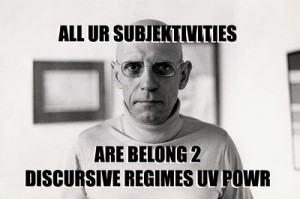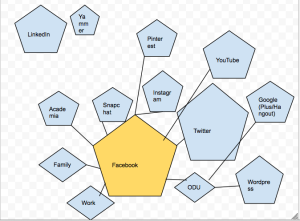 Foucault meme demonstrates the concept that all texts are nodes in a network.
Foucault meme demonstrates the concept that all texts are nodes in a network.
I love me some Foucault. But he’s like a fine French truffle, rich with complex flavors. You have to take small bites and savour. Unfortunately, we are on the American “turn the table” restaurant mentality, rather than the French “it’s yours for the evening” way of dining. I’ve eaten my way through the first part of Archaeology of Knowledge, but I’ve got the post-American Buffet bloat and indigestion from eating too much too fast. Still, I’m going to try to interrogate the “dubious unities” and put together some discursive formations that make meaning. You’ll only be able to discern the meaning by reading my blog in conversation with other students’ blogs, though. If you’re trying to determine “the intention of [this] author, the form of [my] mind, the rigour of [my] thought, the themes that obsess [me] or the project that traverses [my] existence and gives it meaning” (28-29), you’ll have to look elsewhere, for Foucault and I do not broke any of that humanist, psychological nonsense that relies on presuppositions of origin, unity, tradition, text, or oeuvre. What appears here, in this entry, is the product of choices I made, governed by the rules given for this blog assignment, which caused these statements to be made, and not others (27). What is unsaid here is as important as what is said; I am only able to make this particular discursive irruption at this moment in time, given what knowledge I currently have, the constraints of my time, vocabulary, and capacity for understanding, and in the context of the other discursive irruptions that influence my thought and language choices — most recently, those of Bitzer, Vatz, and Biesecker, who each examined the cause and purpose of discourse.
As I was reading the first couple of chapters, I was struck by multiple places where Foucault seems to predict Big Data and algorithmic decision-making facilitated now by our online mouse-droppings and consumption of cookies. Foucault says that “controlled decisions” can constitute “discursive groups that are not arbitrary, and yet remain invisible” (29). Certainly controlled decisions that define conditions are what creates membership in affinity groups, visible online via social networks, but what is invisible is what is economically valuable. The ability to dynamically create discursive groups that are logically and logarithmically constituted based on the interplay of online choices — that potential to subdivide and reintegrate people into groups and analyze them to make predictions about them, about what they will do or say or not do or say — is the basis of Google’s and Facebook’s stock price.
These discursive groups remain invisible, but they are called into being via a query made by someone with a rhetorical purpose.
The situation is created, the entity is constituted into a unity temporally and temporarily via a system of rules and conditions which remain completely invisible — and un-thought-of — by most people interacting with the system. These rules or protocols, such as Google’s algorithms, must be scrutinized, Foucault says, to determine their legitimacy, and never accepted as self-evident (25-26). Much of the worldwide web functions in this semblance of a unity; many web pages do not exist beyond the time that they are served up in response to a query from a user. The page utters its discursive forms, but we do not often question, “how is it that one particular statement appeared rather than another?” (27). How does Google decide which results are at the top, or which word to offer as a translation? And do we stop to consider what is not said, and whether the meaning we seek is in what we did not see, hear, or read, or were even given the opportunity to see, hear, or read?
This same question of how one thing was said instead of another has a huge connection to my object of study and intended research. My friend and I call it the George R.R. Martin question: in a world of fantasy, where one can imagine anything at all, why does one continue to imagine institutionalized and fetishized objectification of and violence against women? Foucault’s “description of the events of discourse” rather than a language analysis can get at the decisions that are made and to look at the connections and situatedness of the discourse to determine how it became so. In my object of study, Live-Action Role Playing Games (LARPs), there are many examples of the George R.R. Martin question, where imaginative games continue to reinforce gender stereotypes, heteronormativity, patriarchal constructs, and other constructs brought into the game world by the designers, players, or both. Foucault states that a language (langue) is “a system for possible statements, a finte body of rules that authorizes an infinite number of performances” (27). Unlike a computer game or a table-top game where choices are forced by the spaces on the game board or the software, in a LARP game mechanics and a character are only a set of protocols. The game itself is a discursive irruption and the live, autonomous players can perform an infinite number of copies or instances using the same protocols and rules and, each will be different and distinct, and unable to be replicated. Foucault’s concept of “points of diffraction of discourse” (65) also seems to bear fruit in looking at a LARP, since it deals with simultaneities of enunciation and “points of equivalence.” A LARP’s mechanics attempt to regulate and mitigate such incompatibilities and potential conflicts which exist within this particular “discursive constellation”, which Foucault recognizes is in conversation withe other discourses. Analyzing the system that surrounds a LARP and what is in place to allow or disallow such reconstituted representations seems to be fruitful.
Foucault is talking about doctors in chapter 4, but this description of how they are situated as subjects in their institution could very well describe the position of a player in a LARP. A player is “also defined by the situation that it is possible for him to occupy in relation to the various domains or groups of objects [other player-characters, non-playing characters, props, the physical space, his own body within the space]: according to a certain grid of explicit or implicit interrogations [his character sheet, character goals, abilities, status], he is the questioning subject [seeking information] and, according to a certain programme of information, he is a listening subject [in conversation with other information-seekers]; according to a table of characteristics [physical and character abilities] he is the seeing subject, and, … the observing subject; … he uses instrumental intermediaries [questions, actions, gestures, objects, character traits and abilities] to modify the scale of the information” (52). A gamer does this to interact with others, learn the exigence of the scene, further his own in-game (and perhaps, out-of-game) goals, and in order to experience pleasure. His boundaries are circumscribed some by the system (the game protocols), the materiality/physicality (his own and the physical space) and the constraints given him by the Game Master (GM) or the exigence of the scene, or the actions of others. This unfolds dynamically, discursively and ultimately narratively between and among the interactions of the other subjects, who occupy this same theoretical and discursive space, and who, collectively or individually, can derail this game by making choices about what is said and done that are possible, but not necessarily probable, given the situation. When an unexpected discursive act occurs, it is no longer the same game, the unity is broken, and a new unity must be co-created, instantaneously.
My favorite Foucault quote though is that a book is merely a “node within a network” (23), perhaps because it is short, but also perhaps because it brings to mind that a text is only an instance of an idea. It takes me back to my librarian days, when we were discussing the shift from one type of cataloging system (AACR) to the new one, adopted in 2010, Resource Description and Analysis (RDA). It completely upends how a library describes objects in its collection, and is made for the digital age. Items are now clustered under the work, which can appear in a variety of formats. For example, the entry would be Hamlet, by William Shakespeare, and clustered under it would be all the instances that refer to that intellectual work. It could be a print copy of the play, or a DVD, or another DVD of another performance, or an online resource, or a prose translation, a children’s story, a YouTube video, a parody, etc. ALL are instances or expressions or nodes that are part of the network that is Hamlet. Format doesn’t mean it’s a different thing, only part of a greater whole that all, individually and together, constitute the meaning itself. The relationship and interplay between all nodes/formats can now be visualized with RDA, whereas with AACR, we could only see “a population of dispersed events” (22). Now, these nodes can talk to each other, and those wishing to enter the discourse have a modality that enables them to join.
Works Cited
Foucault, Michel. The Archaeology of Knowledge ; and the Discourse on Language. New York: Pantheon Books, 1982. Print.
Herman, Alison. “The ‘Game of Thrones’ Universe Is Violent and Sexist — And That’s Not a Bad Thing.” Flavorwire. Web. 21 Jan. 2014.
“Resource Description & Access.” Joint Steering Committee for Development of RDA. Web. 21 Jan. 2014.
***************************************************************************


